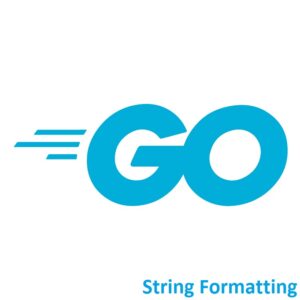
Effective String Formatting Techniques!
Welcome to the world of Golang! String formatting is the art of manipulating and presenting data in a structured and readable manner. In Golang, formatting strings is key to producing well-organized output for various purposes, from logging to user interfaces. This guide shows some of the methods and functionalities available in Golang for formatting strings, empowering you to wield this skill effectively in your projects.
Here are some common ways to format strings in Go:
In Go, string formatting is typically done using the fmt package, which provides functions for formatting and printing strings. The fmt package is similar to the C’s printf and scanf functions.
Printing to the standard output
package main
import "fmt"
func main() {
name := "John"
age := 30
fmt.Printf("Name: %s, Age: %d\n", name, age)
}
//Output is Name: John, Age: 30
In the Printf function, the %s and %d are format specifiers. They indicate where and how the values of name and age should be inserted into the string.
Sprintf Formatting to a string variable
package main
import "fmt"
func main() {
name := "Alice"
age := 25
result := fmt.Sprintf("Name: %s, Age: %d", name, age)
fmt.Println(result)
}
//Output is Name: Alice, Age: 25
The Sprintf function formats the string and returns the formatted result as a string, which can be stored in a variable.
Formatting with Fprintf to write to a file or any io.Writer
package main
import (
"fmt"
"os"
)
func main() {
file, err := os.Create("output.txt")
if err != nil {
fmt.Println("Error:", err)
return
}
defer file.Close()
name := "Bob"
age := 35
_, err = fmt.Fprintf(file, "Name: %s, Age: %d\n", name, age)
if err != nil {
fmt.Println("Error:", err)
}
}
In this example, we create a file and use Fprintf to write the formatted string to that file.
String Concatenation
Go also allows you to concatenate strings using the + operator:
package main
import "fmt"
func main() {
firstName := "Jane"
lastName := "Doe"
fullName := firstName + " " + lastName
fmt.Println(fullName)
}
//Output is Jane Doe
String Padding
Padding is the process of adding extra characters to a string to achieve a desired length or format. In GoLang, padding is commonly used to ensure consistent alignment and visual appeal when displaying data. There are two primary types of padding: left padding and right padding.
Left Padding:
Left padding involves adding characters to the beginning (left side) of a string to reach a specified length.
In GoLang, you can achieve left padding using the fmt package’s Printf function and formatting verbs such as %s and %*s.
For example:
width := 10
text := "GoLang"
formatted := fmt.Sprintf("%*s", width, text)
fmt.Println(formatted) // Outputs: " GoLang"
In this example, %*s tells Sprintf to allocate a width of 10 characters for the string text. Since the string itself is shorter than the width, spaces are added to the left side to reach the specified width.
Right Padding:
Right padding involves adding characters to the end (right side) of a string to meet a specific length.
Similarly, using fmt package functions, you can achieve right padding.
For example:
width := 10
text := "GoLang"
formatted := fmt.Sprintf("%-*s", width, text)
fmt.Println(formatted) // Outputs: "GoLang "
In this example, %-*s indicates that the string text should be left-aligned and occupy a width of 10 characters. Since the string is shorter than the width, spaces are added to the right side to reach the specified width.
Practical Use Cases:
Padding techniques are often used in tabular data, logging, or any scenario where consistent alignment and formatting are required. For instance, in displaying tables, ensuring uniform column widths using padding can enhance readability and presentation.
Understanding and employing padding techniques in GoLang allows you to control the visual appearance of your output, ensuring consistency and readability across different contexts.
Precision Control
Floating-Point Precision:
When dealing with floating-point numbers, you can control the precision—the number of decimal places—displayed in the output using formatting verbs such as %f or %e in the fmt package.
For example:
value := 3.14159265359
fmt.Printf("%.2f", value) // Outputs: "3.14"
In this case, %.2f specifies that the floating-point value should be displayed with a precision of two decimal places.
String Length Precision:
For strings, you can control the maximum number of characters to display using precision control in formatting verbs such as %.*s.
text := "Hello, GoLang!"
fmt.Printf("%.5s", text) // Outputs: "Hello"
Here, %.5s instructs Go to display only the first five characters of the string text.
Practical Use Cases:
- Financial Applications: Precision control is crucial when displaying monetary values to ensure accuracy without displaying unnecessary decimal places.
- Displaying Data: When working with large datasets, controlling precision helps in presenting only relevant information without overwhelming the viewer with excessive details.
Additional Points to Note:
- Precision control is often used in combination with other formatting options to achieve desired output formats.
- For different formatting verbs (
%f,%s,%e, etc.), precision control might have slightly different behaviors, so it’s essential to refer to the GoLang documentation or experiment to understand their nuances.
By leveraging precision control in string formatting, you can tailor the display of numerical values and strings to meet specific requirements, presenting data in a clear, concise, and easily digestible format.
Conclusion
Remember that in Go, string formatting is type-safe, meaning you should use the appropriate format specifier for the data type you’re inserting into the string. Using the wrong format specifier can result in runtime errors or unexpected behavior. Armed with knowledge about various formatting techniques, precision control, and padding, you can create visually appealing and well-structured output, enhancing the readability and usability of your Go programs.
That’s All Folks!
You can find all of our Golang guides here: A Comprehensive Guide to Golang




